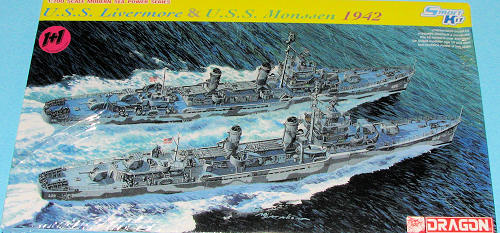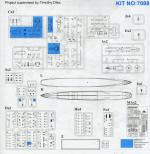
Dragon 1/700 USS Livermore & USS Monssen (1942)
| KIT #: | 7088 |
| PRICE: | $25.00 MSRP |
| DECALS: | One option per ship |
| REVIEWER: | Scott Van Aken |
| NOTES: | Smart kit |

| HISTORY |
For the Livermore history, see the 1/350 Preview.
Monssen was laid down 12 July 1939, by Puget Sound Navy Yard, Bremerton, Washington; launched 16 May 1940, sponsored by Mrs. Mons Monssen, widow of Lieutenant Monssen, and commissioned 14 March 1941, Lieutenant Commander R. N. Smoot in command.
Following shakedown and training, Monssen reported to the Atlantic Fleet on 27 June 1941 as a unit of Destroyer Division 22 (DesDiv 22). For the next five months she operated in the northwestern Atlantic, from the coast of New England and the Maritime Provinces to Iceland, on neutrality patrol. Her escort and patrol duties changed from neutral to belligerent 7 December 1941, continuing until 9 February 1942 when she entered the Boston Navy Yard for overhaul in preparation for her transfer to the Pacific Fleet.
On 31 March she arrived at San Francisco, joined Task Force 16 (TF 16), and departed 2 April. Steaming west, she was in the antisubmarine screen for Hornet (CV-8) as the aircraft carrier headed for Japan with Lt. Col. Jimmy Doolittle's B-25s on her flight deck. In the early morning hours 18 April the force was sighted by the enemy and the Army pilots manned their planes, ignoring the bad weather, the daylight hours, and the additional 168 miles they would have to fly over the planned 500 miles to their targets, Tokyo, Nagoya, Osaka, and Kobe.
Following the Doolittle Raid, the force returned to Pearl Harbor, from which it sortied 30 April to aid Yorktown (CV-5) and Lexington (CV-2) in the Battle of the Coral Sea. Reaching the scene after the battle was over, the force returned to Pearl Harbor, arriving 26 May. Two days later they departed again — this time for Midway to repulse an expected assault on that advanced base. By 2 June, TF 16 had rendezvoused with Task Force 17 (TF 17) and was in position 350 miles northeast of Midway. On the 4th the Battle of Midway commenced as Japanese carrier planes flew against installations on the island. By the 7th, the American forces had won one of the decisive battles of history, sinking four carriers and one cruiser at the cost of destroyer Hammann (DD-412) and carrier Yorktown, and profoundly changing the course of the war.
After Midway the force remained at Pearl Harbor for a month before departing again for combat. Steaming via the Tonga Islands, they headed for the Japanese held Solomons. By 7 August they were 40 miles from the targets, Guadalcanal and Tulagi. On the 7th and 8th, Monssen with Buchanan (DD-484) stood off Gavutu and Tanambogo, circling those islands and providing fire support to units of the 2nd Marine Regiment as the U.S. Navy struck with the first of its giant amphibious assaults. She was then assigned to the screening forces guarding the eastern approaches to Sealark, Lengo, and Nggela Channels.
She remained in the immediate area through the Battle of the Eastern Solomons, which prevented Japanese reinforcements from reaching Guadalcanal, and then took up duties patrolling the sea routes to Guadalcanal. At the end of the month Saratoga (CV-3) was damaged and Monssen was one of the ships designated to escort her to the Tonga Islands.
Monssen returned to Guadalcanal 18 September to insure the integrity of an Allied supply line and to block Japanese efforts at resupply. On 8 November, she departed Nouméa with two cruisers and two other destroyers as Task Group 67.4 (TG 67.4), under Rear Admiral Daniel J. Callaghan, as escort for transports carrying reinforcements to the marines on Guadalcanal. At the same time, another convoy set out from Espiritu Santo, covered by one cruiser and four destroyers under Rear Admiral Norman Scott. Arriving off Lunga Point on the 12th, a day after those from Espiritu Santo they commenced unloading. By dusk as reports of Japanese ship movements from Truk increased, 90 percent of the transports had been unladen despite afternoon torpedo plane attacks, one of which had cost Monssen the use of her fire control radar. The transports were pulled out, escorted through Lengo Channel, and seen safely on their way to Espiritu Santo. Then Admiral Callaghan's force, heavily outnumbered even with the addition of Admiral Scott's ships, reversed course and steamed back to engage the enemy in the initial action of what would later be called the Naval Battle of Guadalcanal.
Shortly, after 01:40, 13 November, they sighted the enemy fleet, under Vice Admiral Hiroaki Abe, 3 miles north of Kukum. The enemy was headed toward Henderson Field — to bombard it and cripple Allied air operations long enough to sneak in 11 of their transports, then en route to relieve their beleaguered comrades fighting on the island.
Battle was given at 01:50. At about 02:20 Monssen, forced to rely on radio information and optics, was spotlighted, hit by some 39 shells, including 3 of battleship caliber, and reduced to a burning hulk. Twenty minutes later, completely immobilized in all departments, the ship was ordered abandoned. After daybreak Monssen was still a floating incinerator. C. C. Storey, BM2c, L. F. Sturgeon, GM2c, and J. G. Hughes F1c, climbed back into the inferno and rescued eight men still aboard and alive, five of whom lived after reaching land. The survivors, 40 percent of the crew, were picked up at about 08:00 and taken to Guadalcanal. The ship herself continued to blaze until early afternoon, when the waters of Ironbottom Sound closed over her.
Monssen was awarded four battle stars for World War II service.
In 1992, an expedition headed by oceanographer Robert Ballard found the wreck of Monssen and other ships sunk during the Solomon Islands battles. The wreck lies upright on the bottom of the sound, with the gun turrets still trained out to the starboard side as they had been in combat.
| THE KIT |
 Here is another very nice Dragon 1/700 kit; based on the larger 1/350 version. You do get two kits in the box, however, one has to be built as full hull and the other as waterline as only one of each hull is provided. Of course, you can cut the lower hull to have two waterline models, but you get the idea. The kit provides the differences between the two ships, an importance to those who really know their ships. The full features list includes:
Here is another very nice Dragon 1/700 kit; based on the larger 1/350 version. You do get two kits in the box, however, one has to be built as full hull and the other as waterline as only one of each hull is provided. Of course, you can cut the lower hull to have two waterline models, but you get the idea. The kit provides the differences between the two ships, an importance to those who really know their ships. The full features list includes:
- Two types of deckhouse newly tooled for Livermore and Monssen
- Extra-fine detail on superstructure walls like hose, ladder patterns delicately reproduced
- Extra gun-tub on Monssen w/20mm gun mounted
- Bridge supports and sky-lookout shield finely represented w/photo-etched parts
- Forward superstructure deck retooled for close mounted 20 mm gun tubs
- Round faced superstructure deckhouse is newly tooled
- Second torpedo mounts and crane w/great details
- Waterline or full hull version can be assembled
- Bilge keels are represented on lower hull by slide mold technology
- Funnels provided w/option of molded on ladders or add on photo-etched ladders
- Lower mount 5-inch guns realistically produced w/extra knuckle
- Turret w/realistic detail
- realistically detailed gun barrels are slide molded w/hollow ends - Optional barrels w/blast bags provided for fun turrets
- Optional barrels w/blast bags provided for fun turrets
- Open topped upper-mount 5-inch gun w/textured canvas cover
- Rudder is movable
- TRUE-to-scale ultra thin propellers reproduced
- Smoke generator w/fine detail
- Extremely fine detailed parts like davits for 26' whale boats
- 5-inch practice loading machine in great detail
- Quintuple torpedo launcher in fine detail
- 36-inch searchlight w/fine detail
- Special device included to bend specific photo-etched parts to correct angle
Of course, the really dedicated will want to add some p.e. railings to this, but as it is, the kit is fine. Instructions are well done with the usual Gunze and Model Master paint references. You might want to pick up some Polly Scale for this one so you won't have to do a lot of mixing. The instructions also show all the differences between the two ships. Decals provided ship numbers and the non-skid for the weather decks.
| CONCLUSIONS |
A truly super pair of destroyer kits and at a most reasonable price. Makes for an excellent display of these two important early war ships.
| REFERENCES |
March 2010 Thanks towww.dragonmodelsusa.com for the preview kit. Get yours today at your local shop or on-line retailer. If you would like your product reviewed fairly and fairly quickly, please contact the editor or see other details in the Note to Contributors.